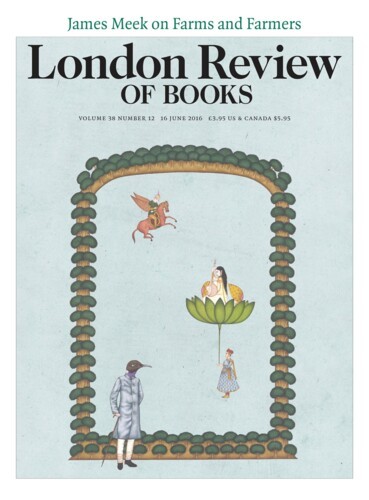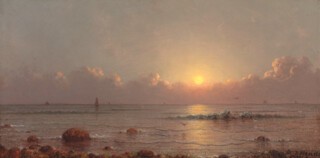The last time a painting from the Hudson River School – the loose grouping of 19th-century American artists who evoked the placid rural villages and forested tourist destinations upriver from New York City – made the news was in 2005, when the New York Public Library, strapped for cash, sold Asher B. Durand’s Kindred Spirits (1849), for $35 million, to the Walmart heiress Alice Walton for her Crystal Bridges Museum in Arkansas. The controversy surrounding the sale, with the usual hand-wringing about cultural patrimony versus institutional needs, obscured the fact that few members of the general public had heard of Durand, or, indeed, of the two ‘kindred spirits’ – the British-born painter Thomas Cole and the Romantic poet and newspaper editor William Cullen Bryant – whom he depicted contemplating a lushly idealised Catskills landscape of bluffs and waterfalls, their names inscribed like those of lovers on a nearby birch tree.
Cole and Durand are reunited in an intimate exhibition of 25 Hudson River School paintings at the Driscoll Babcock Galleries on West 25th Street in Chelsea (until 25 June). Cole’s miniature, sepia-hued View of the Thames (1845) looks back nostalgically to his native country, contrasting – by implication – riparian England with the sublimely rugged Hudson he had begun to paint in 1825, the year the Erie Canal opened in upstate New York to the seemingly opposed interests of commercial development and nature-seeking tourists. Durand’s small and intense Catskill Mountains near Shandaken (c.1856) seems to say – a little hopefully – that this blue-tinged range, river and majestic tree will always be there for us.
It becomes clear that there is another pair of kindred spirits in these Hudson River School pictures: on the one hand, the natural world – already under siege by an expanding economy and the ravages of the Industrial Revolution – and, on the other, sojourning humanity. It was a nodding acquaintance, as Emerson described it in Nature: ‘The greatest delight which the fields and woods minister, is the suggestion of an occult relation between man and the vegetable,’ he wrote. ‘I am not alone and unacknowledged. They nod to me, and I to them.’
The Babcock Gallery, founded in 1852, is the oldest gallery in New York, and has made a great deal of money over the years selling paintings of rural and woodland landscapes to pent-up urbanites. The gallery, now owned by John Driscoll, moved downtown in 2012 from its stodgier precincts on 57th Street. Unlike the Whitney, which, in its choice of what to exhibit, sometimes seems to have jettisoned most of its pre-1960 holdings in the course of its downtown journey, the Driscoll Babcock has retained its commitment to earlier American art, while also representing some living artists. The title of the current exhibition, The Shock of the Old (an allusion to Robert Hughes’s The Shock of the New, about the rise of modern art since Impressionism), is playfully intended to convey the provocation of exhibiting such paintings among the contemporary work on view nearby, at edgier dealers like Pace and Marlborough Chelsea.
The best way to get to Driscoll Babcock is by walking there on the High Line, the elevated railroad that has been converted into a promenade of lawns, trees, gardens and outdoor artwork. (Follow it a dozen streets further south, and you’ll get to the Whitney.) By common consent, the High Line is the best thing to have happened to Manhattan since Central Park. It serves much the same purpose as Central Park and, indeed, of the Hudson River School paintings: to give harried New Yorkers a taste of the landscape that once flourished on their green island, and still does up the Hudson, the ‘lordly’ river (as Washington Irving called it in ‘Rip Van Winkle’) that shimmers between the buildings a few hundred yards from the walkway.
Some of the most interesting paintings on view in The Shock of the Old bring historical grit to the seemingly timeless natural world. Ralph Blakelock is best known for his mysteriously atmospheric paintings of American Indian encampments, and for his later descent into madness. He is represented here by the early, brilliant A Sawmill in the Woods (c.1870), graced with a hand-carved nameplate. Details of the painting are highlighted with a smaller, dark-pigmented brush, as though to convey a maximum amount of information to the viewer. A dilapidated mill is surrounded by cleared land; a huge tree in the foreground is about to join the logs waiting to be dragged away. The wilderness of Durand and Cole is under siege here, prey to the logging interests which, by the end of the century, would inspire the creation of the National Parks. Something else catches the eye in the sunlit centre of the greenery. A little blonde girl dressed in white, seen from the back, watches – she is our stand-in – while her formally dressed father strikes a tough bargain with the African-American tenant of the mill. The picture seems to offer a critique of Reconstruction policies of free labour following the Civil War. Neither the freed slaves nor the natural world appears to be a victor here.
John Driscoll, who happened to be on the premises, told me that ‘the real star of the show’ is Francis Guy’s Harpers Ferry, Virginia, painted in 1808, fifty years before John Brown’s famous raid on the federal armory, which was meant to inspire a slave insurrection across the South. Guy, who follows the classical conventions of 17th-century French landscape painting, with massive hills descending from right and left to the confluence of the Potomac and Shenandoah below, could hardly have known that the rudimentary armory buildings he painted in the foreground would one day be the scene of such a cataclysmic ‘portent’ (as Melville called the raid) of the great war to come. Frederic Church’s luridly surreal Our Banner in the Sky (in a skilled, roughly postcard-size copy made after the war broke out in 1861) is composed of a band of clouds and a cluster of stars lit up, in the shape of the American flag, by the fighting below.
The Civil War pretty much put an end to the aspirations of the Hudson River School, as its Romantic and religious pieties came to seem increasingly provincial and naive. The younger New York-based landscape painters had to strike out for other territory. Albert Bierstadt and Blakelock went west; Church and his sometime studio-mate Martin Johnson Heade (whose arresting paintings of impending thunderstorms have been rather fancifully interpreted by art historians as portending the war), went to South America in search of more exotic sublimities: the Edenic Heart of the Andes for Church and the hallucinatory variety of hummingbirds for Heade.
Heade is perhaps the most interesting of these painters to today’s critics and gallery-goers: art historians have even invented a separate school, Luminism, for him to preside over. He was also among the least commercially successful. He is represented in The Shock of the Old by the gorgeously Luminist Seascape at Sunset (above, probably mid-1860s), reminiscent of the mesmerising seascapes he did in Rio de Janeiro during the war. The painting is in remarkably good condition, showing off the pre-Impressionist effects of fading sunlight on rippling water that are one of Heade’s hallmarks. After failed attempts to mass-produce his vivid South American hummingbird paintings (he aspired to be the Audubon of hummingbirds) and his floral studies, which appealed to Harriet Beecher Stowe, he spent his last years as a painter to the tourist trade at Standard Oil founder Henry Flagler’s Ponce de Leon Hotel in St Augustine, churning out O’Keeffe-like giant magnolia blossoms that surface from time to time on Antiques Roadshow.
As I wandered through the exhibition, I kept thinking of one of Heade’s strangest paintings, recently rehung at the handsomely renovated Wadsworth Atheneum in Connecticut, with the rest of its excellent Hudson River School holdings. Titled Gremlin in the Studio, it depicts the canvas of one of Heade’s majestic (and Monet-like) horizontal views of haystacks arrayed on marshland, perched on top of two sawhorses in his studio. A grinning imp dances mischievously in the dark shadows beneath the picture. We can see the source of its delight: water from the meandering tidal river in the painting is pouring onto the studio floor. Is this an allegory of painterly illusion punctured? Is it a comment on the ultimate sham of producing paintings according to the stereotypical longings of tourists? Whatever the specific message intended, pictures like Heade’s register the simmering discontent latent in much of the art of the Hudson River School painters, a wary sense that their world was about to change, and probably not for the better.
Send Letters To:
The Editor
London Review of Books,
28 Little Russell Street
London, WC1A 2HN
letters@lrb.co.uk
Please include name, address, and a telephone number.


